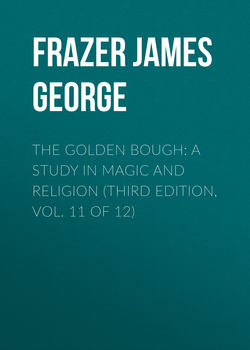The Golden Bough: A Study in Magic and Religion (Third Edition, Vol. 11 of 12)

Реклама. ООО «ЛитРес», ИНН: 7719571260.
Оглавление
Frazer James George. The Golden Bough: A Study in Magic and Religion (Third Edition, Vol. 11 of 12)
Chapter VI. Fire-Festivals in Other Lands
§ 1. The Fire-walk
§ 2. The Meaning of the Fire-walk
Chapter VII. The Burning of Human Beings in the Fires
§ 1. The Burning of Effigies in the Fires
§ 2. The Burning of Men and Animals in the Fires
Chapter VIII. The Magic Flowers of Midsummer Eve
Chapter IX. Balder and the Mistletoe
Chapter X. The Eternal Soul in Folk-Tales
Chapter XI. The External Soul in Folk-Custom
§ 1. The External Soul in Inanimate Things
§ 2. The External Soul in Plants
§ 3. The External Soul in Animals
§ 4. A Suggested Theory of Totemism.586
§ 5. The Ritual of Death and Resurrection
Chapter XII. The Golden Bough
Chapter XIII. Farewell to Nemi
Notes
I. Snake Stones.764
II. The Transformation of Witches Into Cats
III. African Balders
IV. The Mistletoe and the Golden Bough
Отрывок из книги
Bonfires at the Pongol festival in Southern India.
At first sight the interpretation of the European fire customs as charms for making sunshine is confirmed by a parallel custom observed by the Hindoos of Southern India at the Pongol or Feast of Ingathering. The festival is celebrated in the early part of January, when, according to Hindoo astrologers, the sun enters the tropic of Capricorn, and the chief event of the festival coincides with the passage of the sun. For some days previously the boys gather heaps of sticks, straw, dead leaves, and everything that will burn. On the morning of the first day of the festival the heaps are fired. Every street and lane has its bonfire. The young folk leap over the flames or pile on fresh fuel. This fire is an offering to Sûrya, the sun-god, or to Agni, the deity of fire; it “wakes him from his sleep, calling on him again to gladden the earth with his light and heat.”1 If this is indeed the explanation which the people themselves give of the festival, it seems decisive in favour of the solar explanation of the fires; for to say that the fires waken the sun-god from his sleep is only a metaphorical or mythical way of saying that they actually help to rekindle the sun's light and heat. But the hesitation which the writer indicates between the two distinct deities of sun and fire seems to prove that he is merely giving his own interpretation of the rite, not reporting the views of the celebrants. If that is so, the expression of his opinion has no claim to authority.
.....
As the fertility of the land was supposed to depend on these sacrifices, Mannhardt interpreted the victims as representatives of tree-spirits or spirits of vegetation.
Such were the great festivals held once every five years. But besides these quinquennial festivals, celebrated on so grand a scale, and with, apparently, so large an expenditure of human life, it seems reasonable to suppose that festivals of the same sort, only on a lesser scale, were held annually, and that from these annual festivals are lineally descended some at least of the fire-festivals which, with their traces of human sacrifices, are still celebrated year by year in many parts of Europe. The gigantic images constructed of osiers or covered with grass in which the Druids enclosed their victims remind us of the leafy framework in which the human representative of the tree-spirit is still so often encased.86 Hence, seeing that the fertility of the land was apparently supposed to depend upon the due performance of these sacrifices, Mannhardt interpreted the Celtic victims, cased in osiers and grass, as representatives of the tree-spirit or spirit of vegetation.
.....